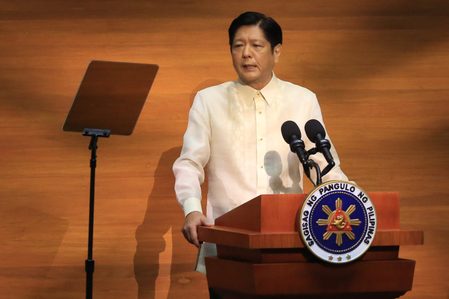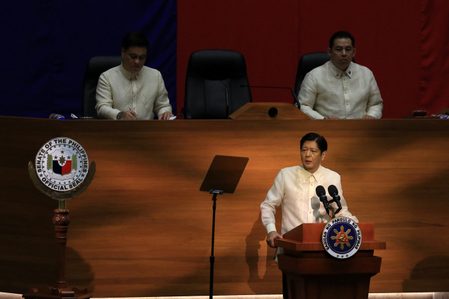SUMMARY
This is AI generated summarization, which may have errors. For context, always refer to the full article.
![[OPINION] Principles in government rightsizing: 5 Es and an A](https://www.rappler.com/tachyon/2022/08/tl-sona-rightsizing.jpg)
The first State of the Nation Address of President Ferdinand Marcos Jr. included several references to the imperatives of governance reform, specifically the need to rightsize the bureaucracy. This would be enabled by the proposed National Government Reorganization Plan (NGRP). This was not surprising – it was expected – considering that all presidents since President Quezon in the ’30s up to President Duterte in 2017 included the imperative to reform government in their agenda. All reform interventions – variously referred to as “reorganization,” “reengineering,” “reinventing,” “rationalizing,” and “rightsizing” initiatives underscored the fundamental principles of economy, efficiency, and effectiveness.
Recall, for instance, that Manuel Quezon set up the Government Survey Board in 1935. Through Executive Order (EO), Manuel Roxas established a Reorganization Committee in 1947. Elpidio Quirino initiated the Government Survey Reorganization Commission in 1950, which became RA 995 in 1954 when Ramon Magsaysay was President. Ferdinand Marcos issued EO 281, constituting the Presidential Commission on Reorganization in 1970. Upon the imposition of martial law in 1972, Marcos Sr. issued Presidential Decree Number 1, setting into motion the massive reorganization of the government through the Integrated Reorganization Plan (IRP). Corazon Aquino in 1986 set up the Presidential Commission on Government Reorganization in 1986. Fidel Ramos issued EO 149 in 1993 to streamline the Office of the President. President Ramos likewise described his efforts to “reengineer” and “reinvent” government, taking off from the National Performance Review of the United States during the time of Bill Clinton. Joseph Estrada reengineered the bureaucracy through EO 165 in 1999. Gloria Macapagal Arroyo issued EO 366 in 2004, calling for a Rationalization Plan. Similarly, Benigno “Noynoy” Aquino issued EO 18 in 2010 to rationalize the Office of the President. President Duterte’s EO 1 in 2016 underscored the imperative to reengineer the Office of the President and eventually rightsize the bureaucracy. The Department of Budget and Management, under the leadership of then secretary Benjamin Diokno, initiated several rightsizing studies for the bureaucracy. Several scholars from the University of the Philippines were involved in these rightsizing studies. There were also accompanying legislative proposals to rightsize the bureaucracy.
It was therefore not surprising that Ferdinand Marcos Jr. – like his predecessors – underscored the need to reform the government through a rightsizing process. Earlier on, Marcos Jr. issued EO 1 reorganizing the Office of the President. In his State of the Nation Address, Marcos Jr. pointed out the urgency of putting the house in order “by rightsizing the government to enhance its institutional capacity to perform its mandate and provide better services while ensuring optimal use of resources.”
Indeed, while the goals of reforming organizations, including the government, are noble, the idea of reforming institutions – in this case, referred to as “rightsizing” – is not new. They are all premised on the fundamental management principles of efficiency, economy, and effectiveness (known as the classic 3Es in management). The National College of Public Administration and Governance (NCPAG) at the University of the Philippines Diliman has been conducting studies on the reorganization of governance over the decades. Jose Abueva published a book on reorganization in 1969. Gonzales and Deapera provided a historical view of reorganization initiatives since the ’50s in the Philippine Journal of Public Administration (1987). UPNCPAG convened a series of fora on governance issues, including one entitled “Reinventing, Reengineering, and Reorganizing the Bureaucracy in the Philippines: Why We Should Be More Hopeful,” published in Diliman Governance Forum (2005). It was a double-edged question, expressing either that there may be hope in reorganizing the bureaucracy once more or exasperation suggesting a cynical view on reorganization. Is it going to be more of the same?
In 2018, we together with Calina, we pointed out the value of reorganizing the state bureaucracy to shed redundancies and eliminate wasteful use of resources. Moreover, lately, in 2021, together with Lorenzo, in an article published in the Global Encyclopedia for Pubic Administration, we argued that reform efforts in government should go beyond the basic principles of reorganization (effectiveness, efficiency, and economy) and suggested the need to consider the principles of equity – ethics and accountability to undergird governance reforms such as rightsizing.
Indeed the principles undergirding the processes of reorganization and rightsizing should go beyond the traditional economy, efficiency, and effectiveness, as seen in the various government reorganization efforts since the ’50s. As commonly understood, economy is about determining the ideal means of achieving goals and objectives quickly and at the lowest possible cost. Efficiency is competently finishing tasks (programs, projects, activities) with the least time and effort. Moreover, effectiveness is accomplishing an organization’s goals following sound processes anchored on its overall mission, with the pertinent national and local authorities capably providing public goods.
Over the years, based on our studies and interactions with many academics and practitioners in public administration at the local, national, and global levels, we have concluded that it is equally important – and relevant – to include the principles of equity and ethics, and accountability in any public sector reform intervention. Equity has two dimensions: one is a preference for the poor and the vulnerable, and the other is an effort to reform governance. Ethics means knowing what is right from wrong. In public service, as provided for in the Code of Ethics and Accountability (RA 6713), civil servants are expected to fulfill their duties with responsibility, righteousness, honesty, and impartiality as much as possible. Finally, accountability – pananagutan – is about an obligation or willingness to accept responsibility, and when called for, the consequences for such actions.
Equity has two major dimensions. Former president Ramon Magsaysay once said in the late ’50s, “those who have less in life should have more in law.” The 2030 Agenda for Sustainable Development (also the Sustainable Development Goals – SDGs) emphasizes reaching the poorest and most vulnerable. The Philippine government has adopted a 25-year long-term vision to end poverty in the country by 2040 (Ambisyon Natin 2040). It is within this context that public sector reforms and reorganizations should be aligned to the principle of equity, more specifically in terms of addressing the needs of the poor and vulnerable in line with the vision articulated by Magsaysay as early as the ’50s into the 2030 SDGs and our very own Ambisyon Natin 2040.
The other dimension of equity in public sector reform concerns the next generation, inter-generational equity. Rightsizing efforts are not only for the present but should consider the long-term effects of such interventions. Rightsizing efforts should not only have long-term perspectives but also should be sustainable. This, therefore, may be framed within the broader context of inter-generational equity.
Finally, public sector reforms must always be founded on the non-negotiable principles of ethics and accountability. Needless to say, graft and corruption continue to be one of the biggest and long-running challenges confronting the Philippines. All administrations have decried corruption. Despite the many reorganization interventions of all administrations, corruption remains a reality. Thus ethics and accountability MUST be among the principles EMBEDDED in designing and implementing public sector reforms and rightsizing strategies.
As mentioned above, after Marcos Sr. imposed martial law, the very first decree he signed was PD 1, implementing the Integrated Reorganization Plan (IRP), which restructured the bureaucracy “to promote simplicity, economy, and efficiency in the government.” This was to be implemented by the Presidential Commission on Reorganization (PCR), which was created in 1970. It was chaired by the brilliant technocrat Armand V. Fabella. PCR’s job was to effectively coordinate all reorganization efforts from various sectors. It included key agencies such as the Department of Budget and Management and the Civil Service Commission. The UP College of Public Administration was also invited to assist the PCR.
President Marcos Jr. might lift a page from his father’s reorganization strategies by creating a Presidential Commission on Rightsizing that would shepherd the proposed NGRP. It would effectively steer, orchestrate, and integrate various rightsizing efforts emanating from all government sectors in accordance with the fundamental and time-honored principles of economy, efficiency, and effectiveness. Nevertheless, as experience has shown, these are not enough. These have to be further reinforced upon the fundamental principles of equity, ethics, and accountability. Indeed, governance reform efforts – including rightsizing the bureaucracy – have to be founded upon the 5Es and an A principles: economy, efficiency, effectiveness, equity and ethics, and accountability. – Rappler.com
Alex B. Brillantes Jr. (abbrillantes@up.edu.ph) is a professor and former dean of the National College of Public Administration of the University of the Philippines and secretary general of the Eastern Regional Organization for Public Administration.
Karl Emmanuel V. Ruiz is a librarian at the UPNCPAG and a part-time researcher at the EROPA.
Add a comment
How does this make you feel?
![[ANALYSIS] Hindi ‘sound’ ang state of the nation](https://www.rappler.com/tachyon/2022/07/tl-itago-ang-mga-resibo.jpg?fit=449%2C449)





![[Just Saying] SONA 2024: Some disturbing points](https://www.rappler.com/tachyon/2024/07/TL-marcos-sona-points-july-23-2024.jpg?resize=257%2C257&crop=335px%2C0px%2C720px%2C720px)

![[OPINYON] Ang unang SONA ni BBM vs People’s Agenda](https://www.rappler.com/tachyon/2022/07/tl-sona-people.jpg?resize=257%2C257&crop_strategy=attention)
![[Newspoint] Junior gives us our cake](https://www.rappler.com/tachyon/2022/07/Junior-Cake.jpg?resize=257%2C257&crop=316px%2C0px%2C720px%2C720px)

![[OPINION] To teach English effectively, teach in the mother tongues first](https://www.rappler.com/tachyon/2022/07/ispeak-mother-tongue.jpg?resize=257%2C257&crop=420px%2C0px%2C1080px%2C1080px)
There are no comments yet. Add your comment to start the conversation.